Sparse Reconstruction-Based Target Localization with Distributed Waveform-Diverse Array Radars
Abstract
1. Introduction
- (i)
- At the configuration stage, the distributed waveform diverse array radar system is formed by three local stations [39,40,41], including two individual FDA-MIMO radars and a single EPC-MIMO radar. Notably, both the FDA-MIMO and EPC-MIMO radars are configured in a colocated MIMO architecture. Specially, the incremental range and angle parameters are measured by the FDA-MIMO radar. In the meanwhile, the range ambiguity index and angle parameters are acquired by the EPC-MIMO radar.
- (ii)
- The Iterative Adaptive Approach (IAA) [42,43,44] and the Atomic Norm Minimization (ANM) [45,46,47] algorithms are employed at FDA-MIMO radar stations for parameter estimation. Simultaneously, the angle and range ambiguity index are acquired by the EPC-MIMO radar through the Coordinate Descent Multiple-Signal Classification (CD-MUSIC) method. Furthermore, based on the single-station estimation results, the WLS method is used by the fusion center to localize targets [48];
- (iii)
- At the analysis phase, both the Cramér–Rao Bounds (CRBs) for the FDA-MIMO and EPC-MIMO radars are derived. In addition, the Root Mean Square Errors (RMSEs) versus the SNRs are provided to verify the effectiveness of the methods. Furthermore, a comprehensive localization error analysis is carried out.
2. Signal Model of Distributed Waveform Diverse Array Radars
2.1. FDA-MIMO Radar
- with the incremental delay w.r.t. the sampling time associated with the target range cell;
- represents the angle-dependent receive steering vector;
- with the transmit waveforms correlation matrix, of which the -th entry of , , and the angle-dependent transmit steering vector;
- denotes the range-dependent steering vector.
2.2. EPC-MIMO Radar
- denotes the transmit steering vector with ;
- , with the amplitude coefficient of the target.
3. Target Localization Based on Sparse Reconstruction
3.1. Target Localization with a Distributed Radar System
3.2. Iterative Adaptive Approach
| Algorithm 1 FDA-IAA |
3.3. Atomic Norm Minimization Approach
| Algorithm 2 FDA-ANM |
3.4. Coordinate Descent Multiple Signal Classification Approach
| Algorithm 3 EPC-CD-MUSIC |
|
3.5. CRBs for the FDA-MIMO Radar and EPC-MIMO Radar
3.5.1. FDA-MIMO Radar
- ;
- ;
- ;
- .
3.5.2. EPC-MIMO Radar
- ;
- ;
- ;
- .
4. Numerical Results
4.1. Performance Analysis of the Sparse Reconstruction Approach
4.2. Performance Analysis of Target Localization Using Sparse Reconstruction with Distributed Waveform Diverse Array Radars
5. Conclusions
Author Contributions
Funding
Data Availability Statement
Conflicts of Interest
Appendix A
Appendix A.1. Details on CRB for the FDA-MIMO Radar
Appendix A.2. Details on CRB for the EPC-MIMO Radar
References
- Peng, Y.; Ding, Y.; Cao, J.; Tang, B.; Jiang, Y. Doppler Radar-Based Target Localization Algorithm Combining Adaptive Linear Chirplet Transform and Frequency Compensation. IEEE Trans. Aerosp. Electron. Syst. 2025, 61, 2057–2067. [Google Scholar] [CrossRef]
- Grossi, E.; Taremizadeh, H.; Venturino, L. Radar Target Detection and Localization Aided by an Active Reconfigurable Intelligent Surface. IEEE Signal Process. Lett. 2023, 30, 903–907. [Google Scholar] [CrossRef]
- Chen, R.; Guo, S.; Chen, J.; Gu, X.; Cui, G.; Kong, L.; Liu, W. Low-Complexity Multitarget Detection and Localization Method for Distributed MIMO Radar. IEEE Trans. Radar Syst. 2025, 3, 599–614. [Google Scholar] [CrossRef]
- Rosamilia, M.; Balleri, A.; Maio, A.D.; Aubry, A.; Carotenuto, V. Radar Detection Performance Prediction Using Measured UAVs RCS Data. IEEE Trans. Aerosp. Electron. Syst. 2023, 59, 3550–3565. [Google Scholar] [CrossRef]
- Mao, Z.; Su, H.; Song, J.; Han, K. Joint Target and Transmitter Localization with AOA and DTD Using Passive Sensors. IEEE Signal Process. Lett. 2024, 31, 1570–1574. [Google Scholar] [CrossRef]
- Wang, H.; Chen, Z.; Zheng, S. Preliminary Research of Low-RCS Moving Target Detection Based on Ka-Band Video SAR. IEEE Geosci. Remote Sens. Lett. 2017, 14, 811–815. [Google Scholar] [CrossRef]
- Cao, X.; Yi, J.; Gong, Z.; Wan, X. Automatic Target Recognition Based on RCS and Angular Diversity for Multistatic Passive Radar. IEEE Trans. Aerosp. Electron. Syst. 2022, 58, 4226–4240. [Google Scholar] [CrossRef]
- Mertens, M.; Ulmke, M.; Koch, W. Ground target tracking with RCS estimation based on signal strength measurements. IEEE Trans. Aerosp. Electron. Syst. 2016, 52, 205–220. [Google Scholar] [CrossRef]
- Shi, C.; Wang, Y.; Salous, S.; Zhou, J.; Yan, J. Joint Transmit Resource Management and Waveform Selection Strategy for Target Tracking in Distributed Phased Array Radar Network. IEEE Trans. Aerosp. Electron. Syst. 2022, 58, 2762–2778. [Google Scholar] [CrossRef]
- Zhang, Z.; Zhou, J.; Wang, F.; Liu, W.; Yang, H. Multiple-target tracking with adaptive sampling intervals for phased-array radar. J. Syst. Eng. Electron. 2011, 22, 760–766. [Google Scholar] [CrossRef]
- Shi, C.; Ding, L.; Wang, F.; Salous, S.; Zhou, J. Joint Target Assignment and Resource Optimization Framework for Multitarget Tracking in Phased Array Radar Network. IEEE Syst. J. 2021, 15, 4379–4390. [Google Scholar] [CrossRef]
- Lan, L.; Xu, J.; Liao, G.; Zhang, Y.; Fioranelli, F.; So, H.C. Suppression of Mainbeam Deceptive Jammer with FDA-MIMO Radar. IEEE Trans. Veh. Technol. 2020, 69, 11584–11598. [Google Scholar] [CrossRef]
- Lan, L.; Xu, J.; Liao, G.; Zhu, S.; So, H.C. Mainlobe Deceptive Jammer Suppression in SF-RDA Radar: Joint Transmit-Receive Processing. IEEE Trans. Veh. Technol. 2022, 71, 12602–12616. [Google Scholar] [CrossRef]
- Zhu, J.; Zhu, S.; Xu, J.; Lan, L. Discrimination of Target and Mainlobe Jammers with FDA-MIMO Radar. IEEE Signal Process. Lett. 2023, 30, 583–587. [Google Scholar] [CrossRef]
- Jing, X.; Su, H.; Li, Z.; Yang, R.; Zhu, Y. Weak Moving Target Detection in Distributed MIMO Radar with Hybrid Data. IEEE Trans. Aerosp. Electron. Syst. 2024, 60, 9291–9306. [Google Scholar] [CrossRef]
- Li, Z.; Ding, Z.; Wang, Y.; Sun, Y.; Li, L. Space Target Detection Based on DBF and GRFT for Ground-Based Distributed Radar. IEEE Geosci. Remote Sens. Lett. 2024, 21, 3504105. [Google Scholar] [CrossRef]
- Yu, Z.; Li, J.; Guo, Q.; Ding, J. Efficient Direct Target Localization for Distributed MIMO Radar with Expectation Propagation and Belief Propagation. IEEE Trans. Signal Process. 2021, 69, 4055–4068. [Google Scholar] [CrossRef]
- Tirer, T.; Weiss, A.J. High Resolution Direct Position Determination of Radio Frequency Sources. IEEE Signal Process. Lett. 2016, 23, 192–196. [Google Scholar] [CrossRef]
- Sadeghi, M.; Behnia, F.; Amiri, R.; Farina, A. Target Localization Geometry Gain in Distributed MIMO Radar. IEEE Trans. Signal Process. 2021, 69, 1642–1652. [Google Scholar] [CrossRef]
- Xie, R.; Luo, K.; Jiang, T. Joint Coverage and Localization Driven Receiver Placement in Distributed Passive Radar. IEEE Trans. Geosci. Remote Sens. 2021, 59, 1094–1105. [Google Scholar] [CrossRef]
- Zhou, Q.; Yuan, Y.; Venturino, L.; Yi, W. Direct Target Localization for Distributed Passive Radars with Direct-Path Interference Suppression. IEEE Trans. Signal Process. 2024, 72, 3611–3625. [Google Scholar] [CrossRef]
- Xia, N.; Xiang, R.; Xing, B.; Gao, D. TDOA Based Direct Positioning of Co-Channel Signals Using Cyclic Cross-Spectral Functions. IEEE Commun. Lett. 2024, 28, 303–307. [Google Scholar] [CrossRef]
- Keskin, M.F.; Gezici, S.; Arikan, O. Direct and Two-Step Positioning in Visible Light Systems. IEEE Trans. Commun. 2018, 66, 239–254. [Google Scholar] [CrossRef]
- Zhu, K.; Jiang, H.; Li, J.; Zhou, F. A Direct Position Determination Method Using Distributed UAVs with Synchronization Error. IEEE Sens. J. 2024, 24, 780–787. [Google Scholar] [CrossRef]
- Song, H.; Wen, G.; Zhu, L.; Li, D. A Novel TSWLS Method for Moving Target Localization in Distributed MIMO Radar Systems. IEEE Commun. Lett. 2019, 23, 2210–2214. [Google Scholar] [CrossRef]
- Zhu, L.; Wen, G.; Liang, Y.; Luo, D.; Jian, H. Multitarget Enumeration and Localization in Distributed MIMO Radar Based on Energy Modeling and Compressive Sensing. IEEE Trans. Aerosp. Electron. Syst. 2023, 59, 4493–4510. [Google Scholar] [CrossRef]
- Lan, L.; Rosamilia, M.; Aubry, A.; De Maio, A.; Liao, G. FDA-MIMO Transmitter and Receiver Optimization. IEEE Trans. Signal Process. 2024, 72, 1576–1589. [Google Scholar] [CrossRef]
- Zhu, J.; Zhu, S.; Xu, J.; Lan, L.; He, X. Cooperative Range and Angle Estimation with PA and FDA Radars. IEEE Trans. Aerosp. Electron. Syst. 2022, 58, 907–921. [Google Scholar] [CrossRef]
- Lan, L.; Rosamilia, M.; Aubry, A.; De Maio, A.; Liao, G. FDA-MIMO Transceiver Design Under the Uniform Frequency Increment Constraint. IEEE Trans. Radar Syst. 2024, 2, 446–459. [Google Scholar] [CrossRef]
- Gui, R.; Wang, W.-Q.; Pan, Y.; Xu, J. Cognitive Target Tracking via angle-range-Doppler Estimation with Transmit Subaperturing FDA Radar. IEEE J. Sel. Top. Signal Process. 2018, 12, 76–89. [Google Scholar] [CrossRef]
- Yu, K.; Zhu, S.; Lan, L.; Xu, J.; Li, X. Resolving Range Ambiguity Using Transmit Coding Modulation and Multi-Pulse Processing in FPC-PA Radar. IEEE Trans. Veh. Technol. 2024, 73, 11168–11181. [Google Scholar] [CrossRef]
- Lan, L.; Rosamilia, M.; Aubry, A.; Maio, A.D.; Liao, G. Single-Snapshot Angle and Incremental Range Estimation for FDA-MIMO Radar. IEEE Trans. Aerosp. Electron. Syst. 2021, 57, 3705–3718. [Google Scholar] [CrossRef]
- Lan, L.; Zhang, Y.; Liao, R.; Liao, G.; Xu, J.; So, H.C. Mainlobe Deceptive Jammer Mitigation with Multipath in EPC-MIMO Radar Exploiting Matrix Decomposition. IEEE Trans. Veh. Technol. 2024, 73, 14674–14688. [Google Scholar] [CrossRef]
- Xu, J.; Zhang, Y.; Liao, G.; So, H.C. Resolving Range Ambiguity via Multiple-Input Multiple-Output Radar with Element-Pulse Coding. IEEE Trans. Signal Process. 2020, 68, 2770–2783. [Google Scholar] [CrossRef]
- Gao, J.; Zhu, S.; Lan, L.; Sui, J.; Li, X. Range-Ambiguous Clutter Separation via Reweighted Atomic Norm Minimization with EPC-MIMO Radar. IEEE Trans. Signal Process. 2025, 32, 146–150. [Google Scholar] [CrossRef]
- Xing, W.; Zhou, C.; Wang, C. Modified OMP method for multi-target parameter estimation in frequency-agile distributed MIMO radar. J. Syst. Eng. Electron. 2022, 33, 1089–1094. [Google Scholar] [CrossRef]
- Chen, H.; Shao, H. Sparse reconstruction based target localization with frequency diverse array MIMO radar. In Proceedings of the 2015 IEEE China Summit and International Conference on Signal and Information Processing (ChinaSIP), Chengdu, China, 12–15 July 2015; pp. 94–98. [Google Scholar]
- Xiong, J.; Wang, W.-Q. Sparse reconstruction-based beampattern synthesis for multi-carrier frequency diverse array antenna. In Proceedings of the 2017 IEEE International Conference on Acoustics, Speech and Signal Processing (ICASSP), New Orleans, LA, USA, 5–9 March 2017; pp. 3395–3398. [Google Scholar]
- Tang, W.-G.; Jiang, H.; Zhang, Q. Range-Angle Decoupling and Estimation for FDA-MIMO Radar via Atomic Norm Minimization and Accelerated Proximal Gradient. IEEE Signal Process. Lett. 2020, 27, 366–370. [Google Scholar] [CrossRef]
- Tang, W.-G.; Jiang, H.; Pang, S.-X. Grid-Free DOD and DOA Estimation for MIMO Radar via Duality-Based 2D Atomic Norm Minimization. IEEE Access 2019, 7, 60827–60836. [Google Scholar] [CrossRef]
- Malanowski, M.; Kulpa, K. Two Methods for Target Localization in Multistatic Passive Radar. IEEE Trans. Aerosp. Electron. Syst. 2012, 48, 572–580. [Google Scholar] [CrossRef]
- Zhang, Y.; Zhang, Y.; Huang, Y.; Li, W.; Yang, J. Angular Superresolution for Scanning Radar with Improved Regularized Iterative Adaptive Approach. IEEE Geosci. Remote Sens. Lett. 2016, 13, 846–850. [Google Scholar] [CrossRef]
- Luo, J.; Huang, Y.; Zhang, Y.; Tuo, X.; Zhang, D. Two-Dimensional Angular Super-Resolution for Airborne Real Aperture Radar by Fast Conjugate Gradient Iterative Adaptive Approach. IEEE Access 2023, 59, 9480–9500. [Google Scholar] [CrossRef]
- Tian, J.; Zhang, B.; Cui, W.; Wu, S. Joint Iterative Adaptive Approach for Sidelobe Suppression and Migration Correction of Migrating Targets. IEEE Trans. Aerosp. Electron. Syst. 2025, 61, 2973–2995. [Google Scholar] [CrossRef]
- Zhang, X.; Zheng, Z.; Wang, W.-Q.; So, H.C. DOA Estimation of Coherent Sources Using Coprime Array via Atomic Norm Minimization. IEEE Signal Process. Lett. 2022, 29, 1312–1316. [Google Scholar] [CrossRef]
- Yang, Z.; Xie, L. Enhancing Sparsity and Resolution via Reweighted Atomic Norm Minimization. IEEE Trans. Signal Process. 2016, 64, 995–1006. [Google Scholar] [CrossRef]
- Hu, X.; Tong, N.; Zhang, Y.; He, X.; Wang, Y. Moving Target’s HRRP Synthesis with Sparse Frequency-Stepped Chirp Signal via Atomic Norm Minimization. IEEE Signal Process. Lett. 2016, 23, 1212–1215. [Google Scholar] [CrossRef]
- Dianat, M.; Taban, M.R.; Dianat, J.; Sedighi, V. Target Localization Using Least Squares Estimation for MIMO Radars with Widely Separated Antennas. IEEE Trans. Aerosp. Electron. Syst. 2013, 49, 2730–2741. [Google Scholar] [CrossRef]
- Lan, L.; Marino, A.; Aubry, A.; Maio, A.D.; Liao, G.; Xu, J. GLRT-Based Adaptive Target Detection in FDA-MIMO Radar. IEEE Trans. Aerosp. Electron. Syst. 2021, 57, 597–613. [Google Scholar] [CrossRef]
- Glentis, G.-O.; Jakobsson, A. Efficient Implementation of Iterative Adaptive Approach Spectral Estimation Techniques. IEEE Trans. Signal Process. 2011, 59, 4154–4167. [Google Scholar] [CrossRef]
- Zhang, Y.; Jakobsson, A.; Yang, J. Range-Recursive IAA for Scanning Radar Angular Super-Resolution. IEEE Geosci. Remote Sens. Lett. 2017, 14, 1675–1679. [Google Scholar] [CrossRef]
- Tian, J.; Zhang, B.; Li, K.; Cui, W.; Wu, S. Low-Complexity Iterative Adaptive Approach Based on Range–Doppler Matched Filter Outputs. IEEE Trans. Aerosp. Electron. Syst. 2023, 59, 125–139. [Google Scholar] [CrossRef]
- Chi, Y.; Chen, Y. Compressive Two-Dimensional Harmonic Retrieval via Atomic Norm Minimization. IEEE Trans. Signal Process. 2015, 63, 1030–1042. [Google Scholar] [CrossRef]
- Donoho, D.L. Compressed sensing. IEEE Trans. Inf. Theory 2006, 52, 1289–1306. [Google Scholar] [CrossRef]
- Yang, Y.; Chu, Z.; Ping, G. Two-dimensional multiple-snapshot grid-free compressive beamforming. Mech. Syst. Sig. Process. 2019, 124, 524–540. [Google Scholar] [CrossRef]
- Yang, Z.; Xie, L. Exact joint sparse frequency recovery via optimizabtion methods. IEEE Trans. Signal Process. 2016, 64, 5145–5157. [Google Scholar] [CrossRef]
- Yang, Z.; Xie, L.; Stoica, P. Vandermonde decomposition of multilevel Toeplitz matrices with application to multidimensional super-resolution. IEEE Trans. Inf. Theory 2016, 62, 3685–3701. [Google Scholar] [CrossRef]
- Liu, Z.; Wu, J.; Yang, S.; Lu, W. DOA Estimation Method Based on EMD and MUSIC for Mutual Interference in FMCW Automotive Radars. IEEE Geosci. Remote Sens. Lett. 2022, 19, 3504005. [Google Scholar] [CrossRef]
- Hu, Y.; Deng, W.; Zhang, X.; Wu, X. FDA-MIMO Radar with Long-Baseline Transmit Array Using ESPRIT. IEEE Signal Process. Lett. 2021, 28, 1530–1534. [Google Scholar] [CrossRef]
- De Maio, A.; Orlando, D. Adaptive Radar Detection of a Subspace Signal Embedded in Subspace Structured Plus Gaussian Interference via Invariance. IEEE Trans. Signal Process. 2016, 64, 2156–2167. [Google Scholar] [CrossRef]
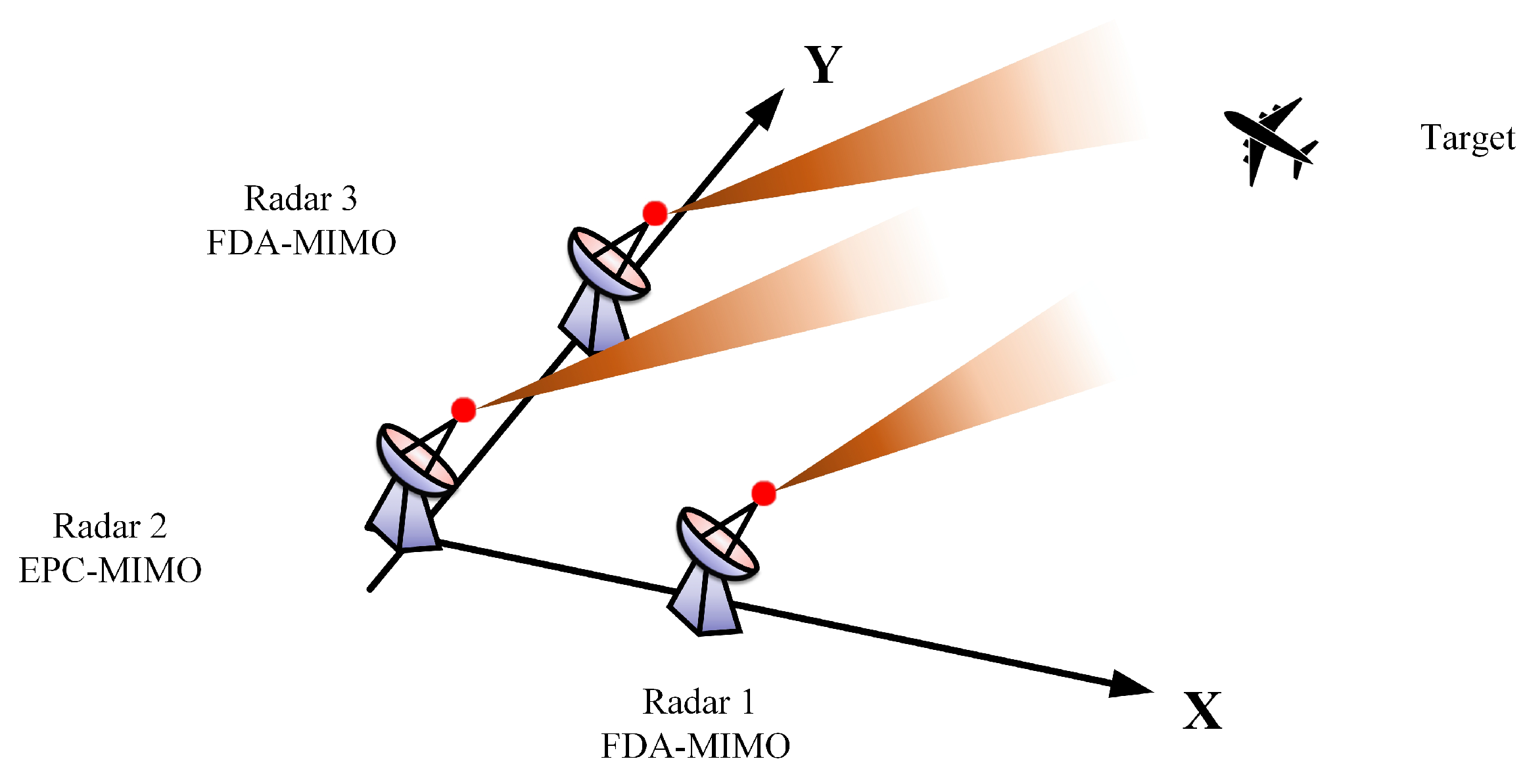
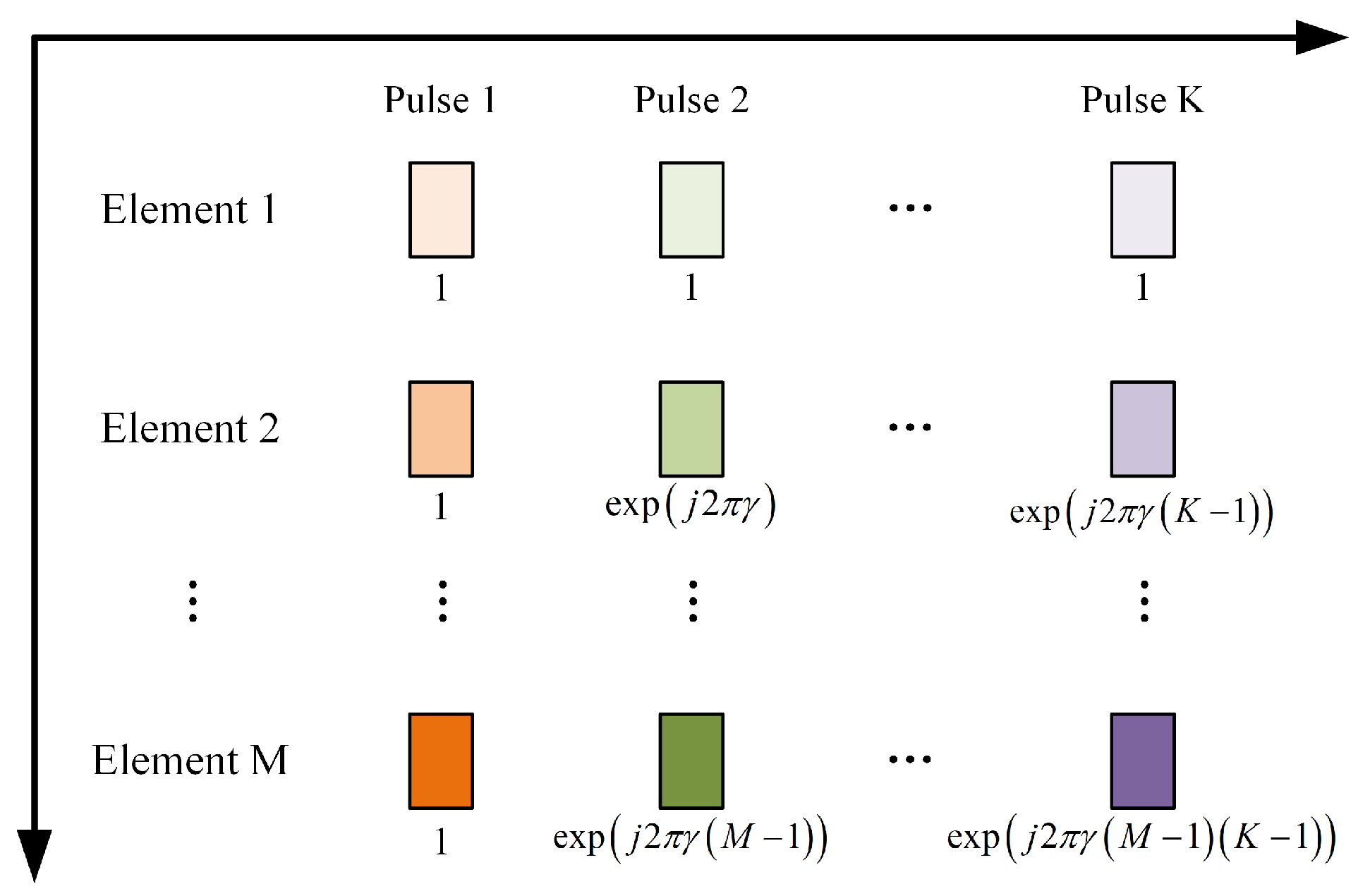
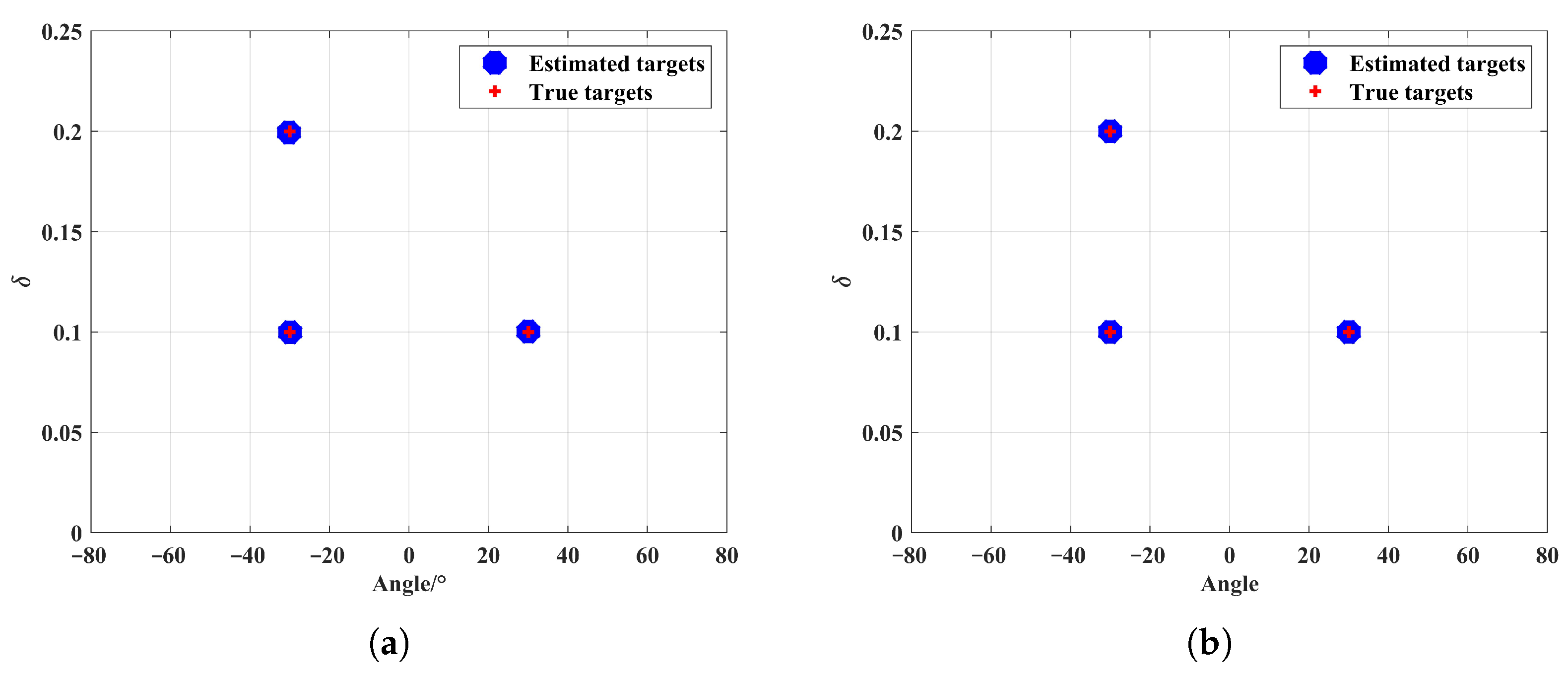
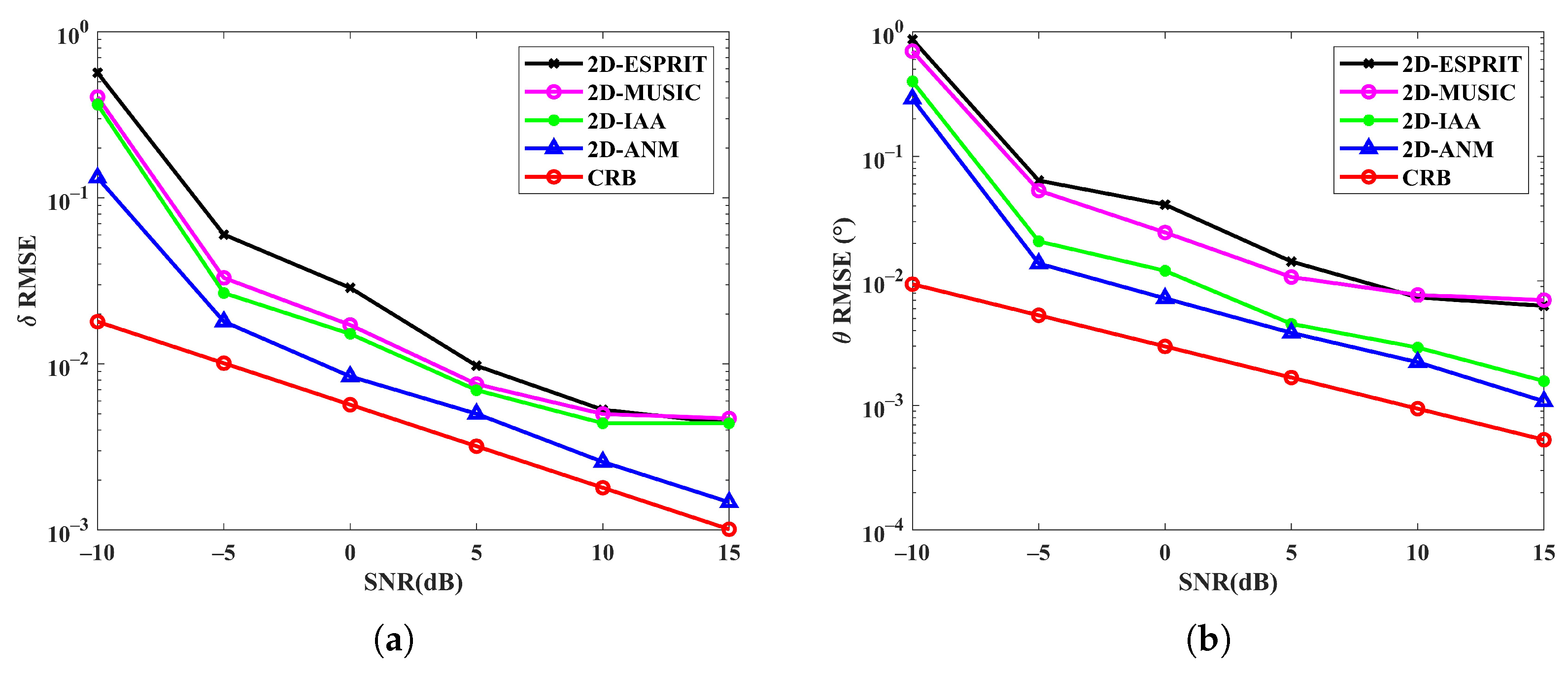


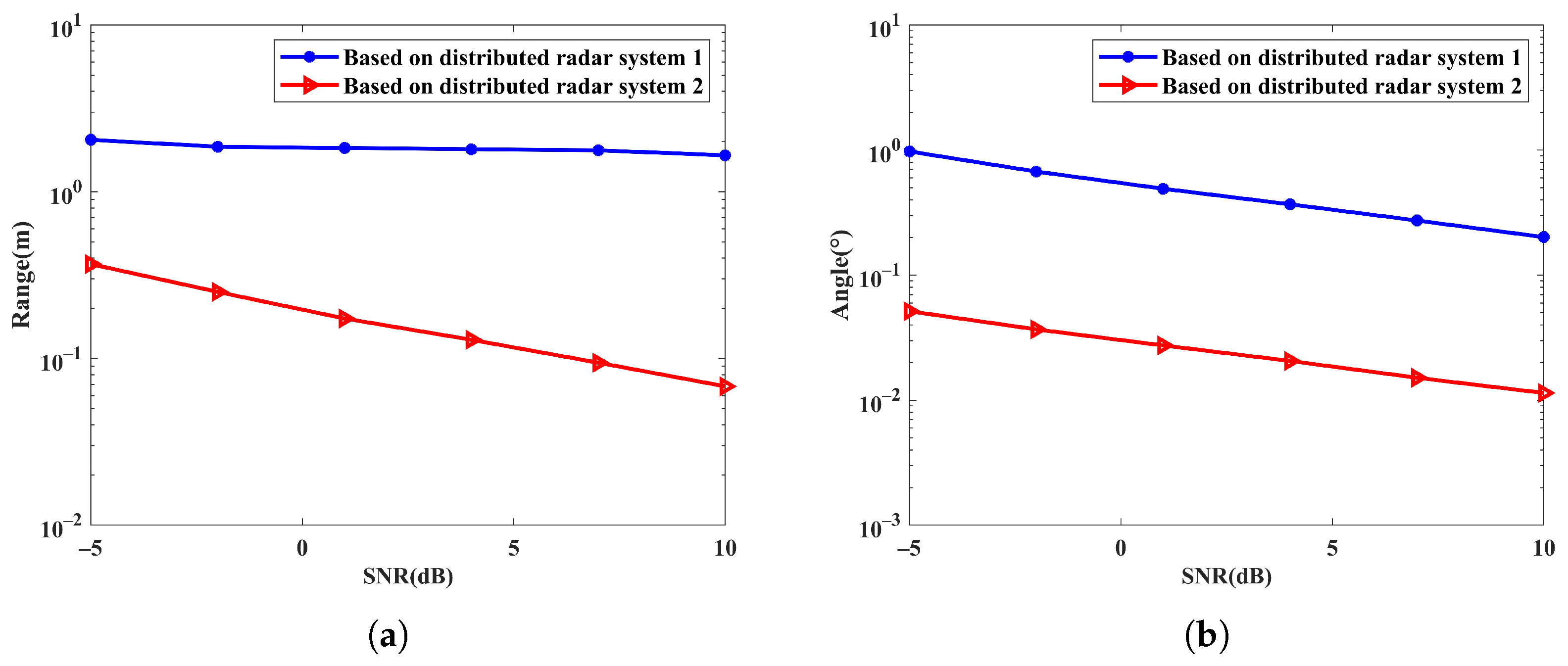
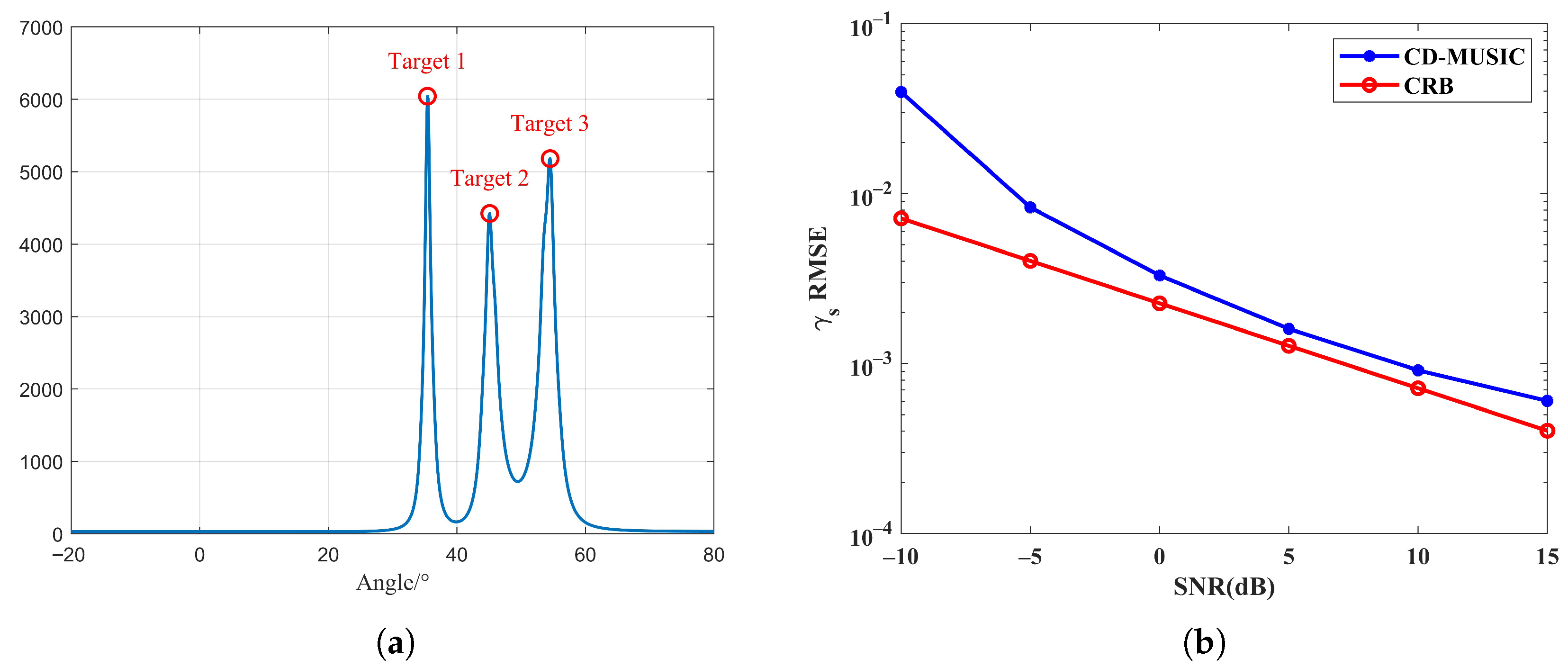
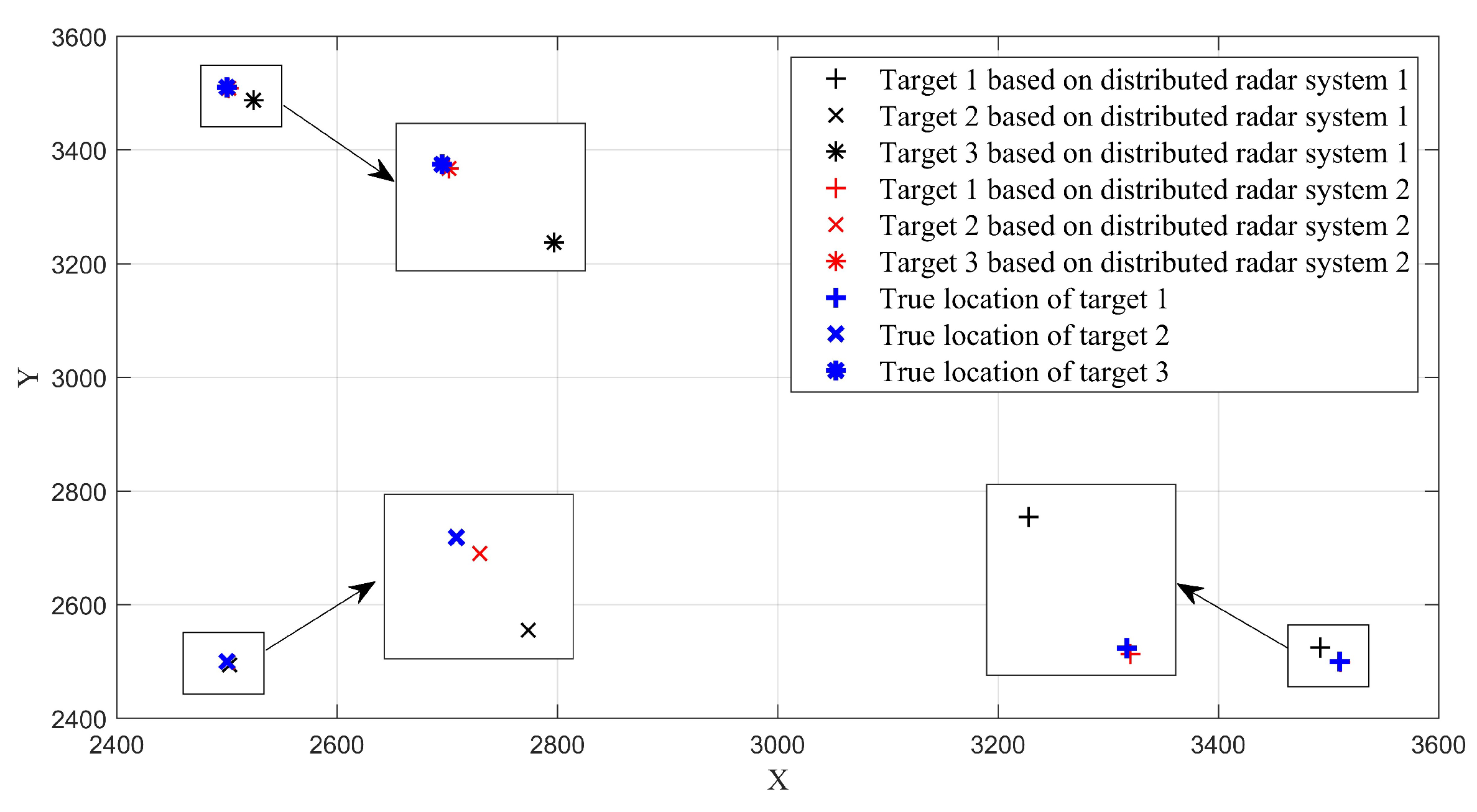

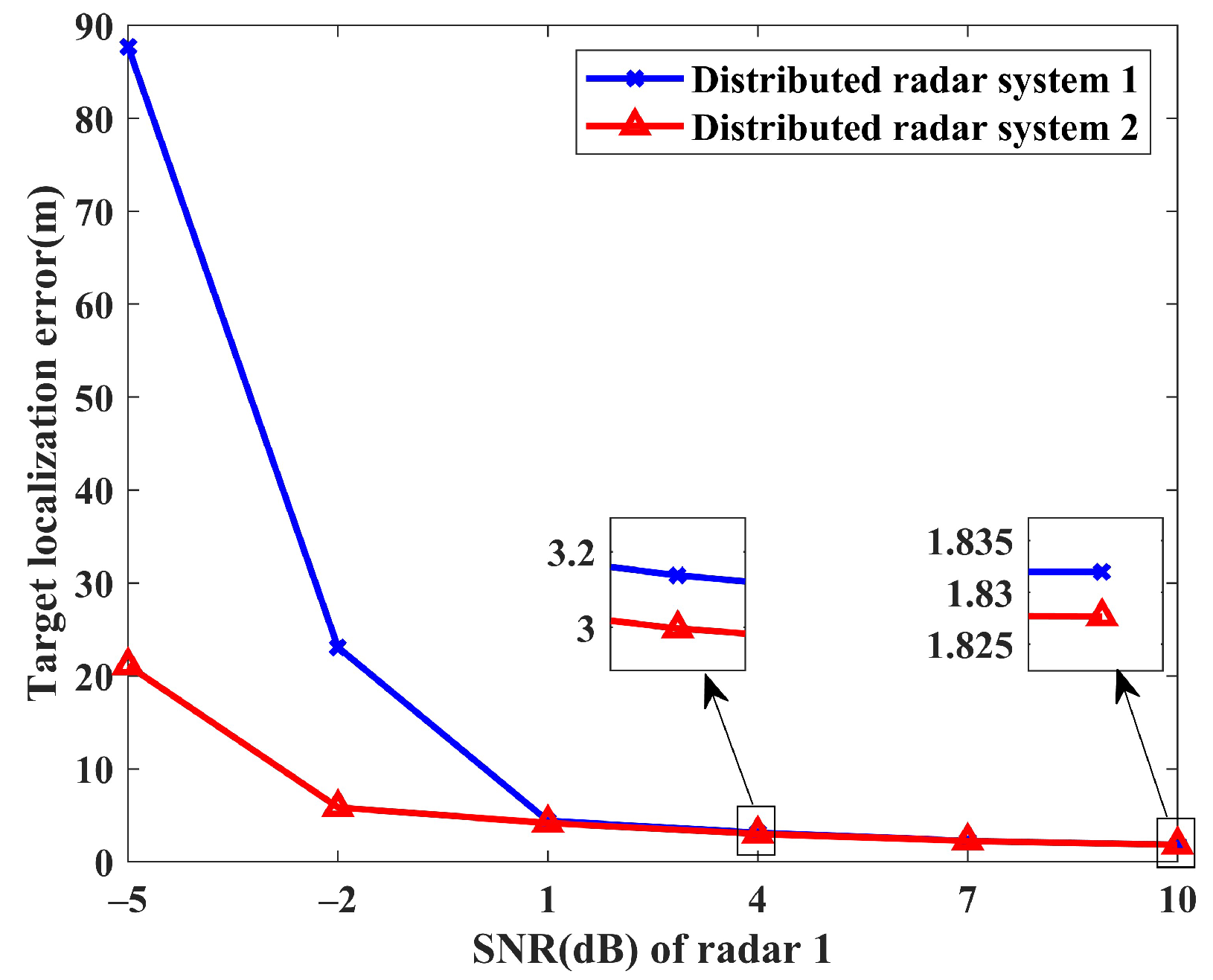
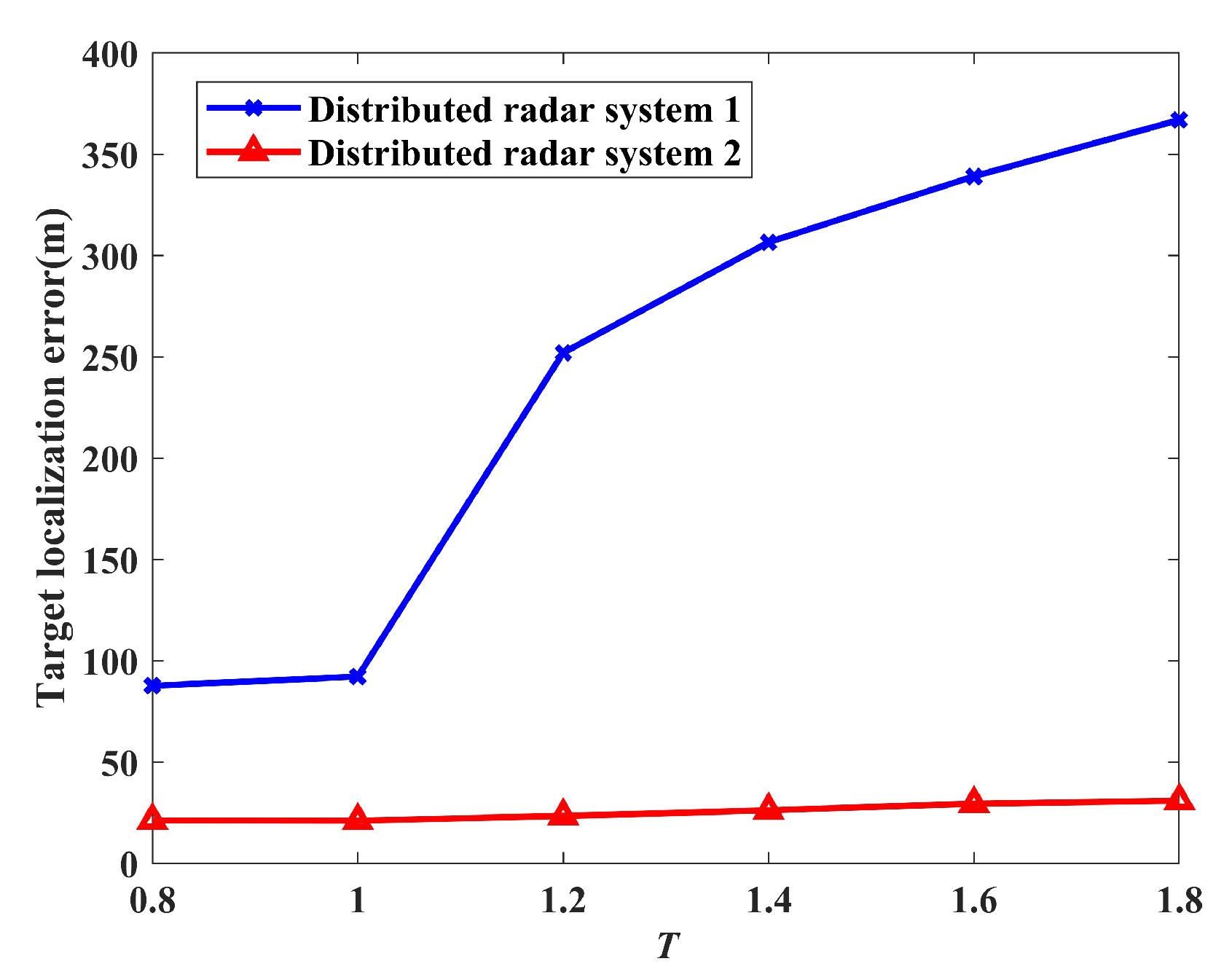
| Parameter | Value | Parameter | Value | Parameter | Value |
|---|---|---|---|---|---|
| M | 10 | N | 10 | K | 6 |
| B | 10 MHz | 5 MHz | 10 GHz | ||
| 0.1 | 75 kHz |
| Parameter | Value | Parameter | Value |
|---|---|---|---|
| Target 1 | (3510, 2500) | Radar 1 | (1000, 0) |
| Target 2 | (2500, 2500) | Radar 2 | (0, 0) |
| Target 3 | (2500, 3510) | Radar 3 | (0, 1000) |
Disclaimer/Publisher’s Note: The statements, opinions and data contained in all publications are solely those of the individual author(s) and contributor(s) and not of MDPI and/or the editor(s). MDPI and/or the editor(s) disclaim responsibility for any injury to people or property resulting from any ideas, methods, instructions or products referred to in the content. |
© 2025 by the authors. Licensee MDPI, Basel, Switzerland. This article is an open access article distributed under the terms and conditions of the Creative Commons Attribution (CC BY) license (https://creativecommons.org/licenses/by/4.0/).
Share and Cite
Ma, R.; Lan, L.; Liao, G.; Xu, J.; Wei, F.; Li, X. Sparse Reconstruction-Based Target Localization with Distributed Waveform-Diverse Array Radars. Remote Sens. 2025, 17, 2278. https://doi.org/10.3390/rs17132278
Ma R, Lan L, Liao G, Xu J, Wei F, Li X. Sparse Reconstruction-Based Target Localization with Distributed Waveform-Diverse Array Radars. Remote Sensing. 2025; 17(13):2278. https://doi.org/10.3390/rs17132278
Chicago/Turabian StyleMa, Runlong, Lan Lan, Guisheng Liao, Jingwei Xu, Fa Wei, and Ximin Li. 2025. "Sparse Reconstruction-Based Target Localization with Distributed Waveform-Diverse Array Radars" Remote Sensing 17, no. 13: 2278. https://doi.org/10.3390/rs17132278
APA StyleMa, R., Lan, L., Liao, G., Xu, J., Wei, F., & Li, X. (2025). Sparse Reconstruction-Based Target Localization with Distributed Waveform-Diverse Array Radars. Remote Sensing, 17(13), 2278. https://doi.org/10.3390/rs17132278








